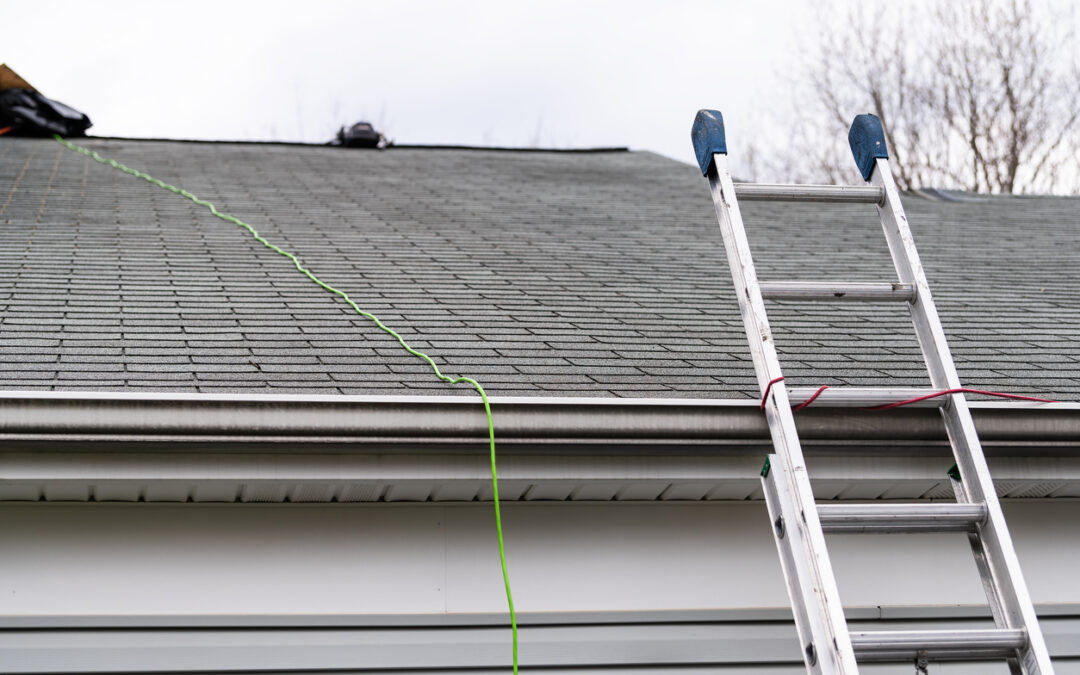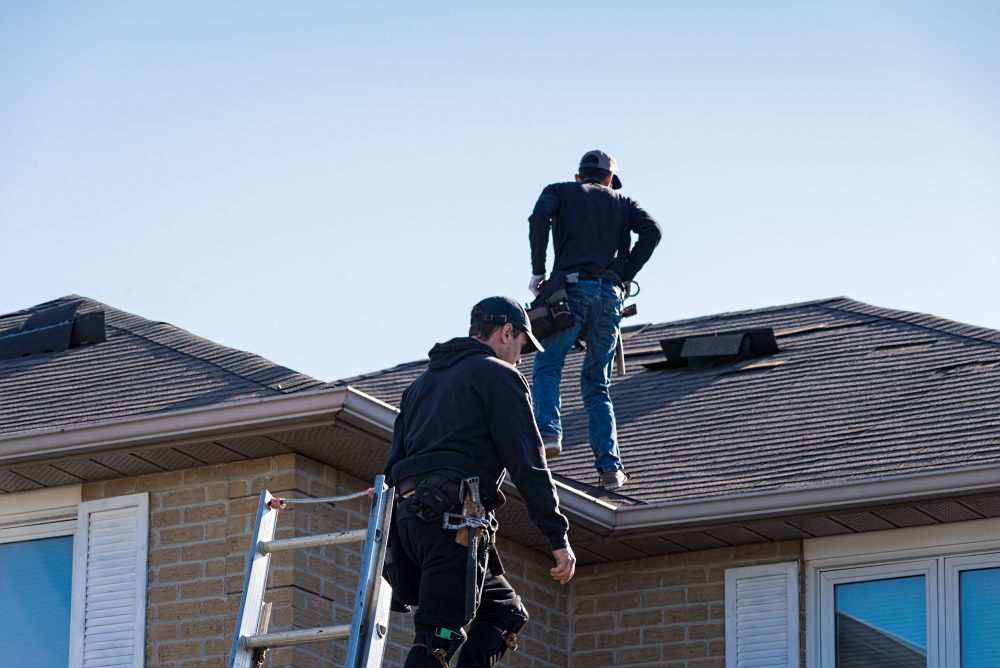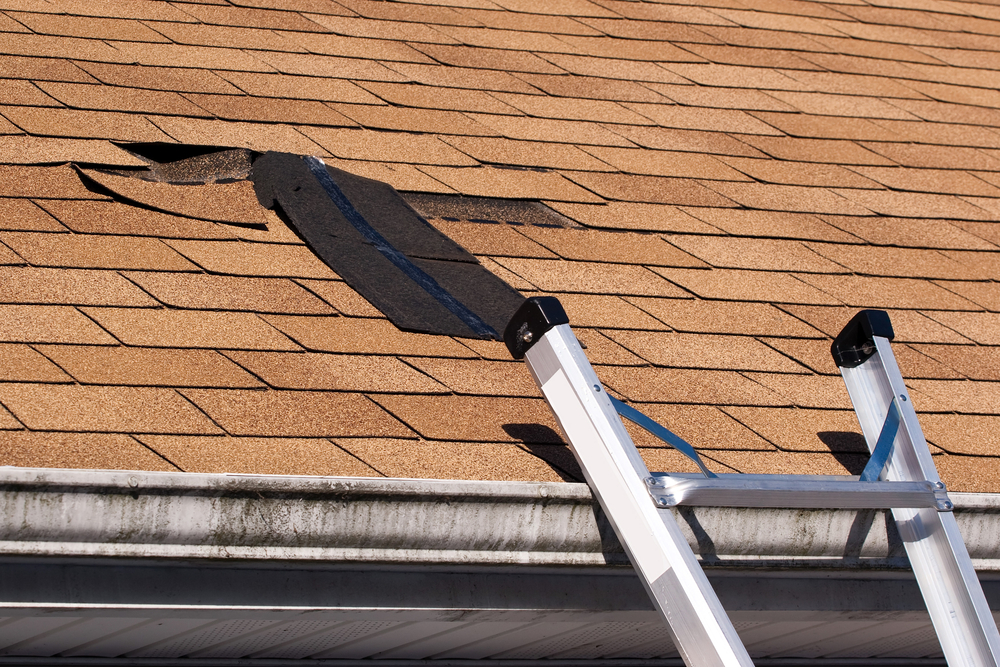
by royalcrownroofing | Sep 21, 2022 | Gutters, Roof Damage, Temporary Roof Repair
If you sit at a computer 16 hours a day, you aren’t in shape to be climbing ladders to make repairs on your roof, even if you aren’t scared of heights. And even if you’re in incredible physical condition, you may want to stay off ladders because they are extremely dangerous. OSHA, in its list of most dangerous jobs, puts roofers as third and that’s because roofers get killed falling off roofs and ladders. So, most of us don’t want to risk it.
Here are some tips for you, though, if you are willing to take the chance and try climbing up onto the roof:
– Make sure the ladder is in good shape, with nothing loose, split, bent or broken.
– Clean up any dirt, grease or dust on the ladder that might cause you to slip.
– Declutter the area before using the ladder.
– Put up the ladder only on a firm, level surface.
– Be sure to face the ladder when climbing up and down to keep your balance.
– Use both hands to securely grip the ladder while climbing.
– Take only small items up the ladder and avoid holding them in your hands.
– Avoid leaning away from the ladder, which can cause you to lose your balance.
– Don’t stand on the two top rungs of the ladder.
– Avoid distractions and stay focused on what you are doing.
Now, if all this seems rather difficult to do, and you want to leave the roof repair and replacement work to the professionals, contact Royal Crown Roofing for their assistance. They are glad to help you.

by siteadmin | Aug 9, 2019 | Roof Damage, Temporary Roof Repair
For many homeowners, DIY repairs offer a quick, inexpensive way to improve your house. There’s certainly plenty of housework that DIY can easily handle. However, for more important home repairs or maintenance, you may not be able to fix the problem yourself. Roof repairs fall into this category.
The safety and efficiency of DIY roof care depend on a number of factors, but fixing the roof yourself is generally not advised. Aside from immediate safety concerns, there is also the possibility that you might only worsen the problem. Consider a few key components before you start your DIY roof project.
Safety Concerns
Roof maintenance does require you to spend a fair amount of time on top of your house. Aside from the possibility of falling over the edge, the damage to your roof could be severe enough that putting additional weight on the roof is not safe. The roof itself could break. Not only does this add more costly repairs to your project, but you could also find yourself falling through a hole in your own roof. You open yourself up to potential risks with DIY roof maintenance.
Thorough Repair Work
Unfortunately, the average homeowner doesn’t always recognize the signs of subtle roof damage. Whether it’s from wear and tear or a particular weather disaster, your roof takes quite a beating with time. Not knowing what roof damage looks like means that you can easily overlook necessary repairs in your DIY project. Hire a professional to perform a thorough roof inspection to make sure you get the best repair possible.
Pro Tip: While it’s best to leave a thorough inspection to the experts, keep an eye on your roof. Check for water damage after heavy storms and call a repair service if anything seems wrong.
When is DIY Appropriate?
For a simple repair, taking care of the problem yourself will cost you less time and money. A few cases where DIY is appropriate include:
- Caulking leaks
- Replacing a couple of shingles
- Cleaning the gutters
- Removing leaves and other small debris
These small projects require little effort or precision to get exactly right, so the risks involved in performing these repairs yourself is minimal. However, don’t overestimate your abilities. If your roof is badly damaged or needs more extensive repairs, save yourself a headache and call a professional.
Extend the Life of Your Woodlands Roof with Professional Maintenance
Roof care may not be a major concern for you unless you’re dealing with severe leaks or damage. But if you regularly have your roof inspected by a professional and perform small DIY maintenance yourself, you can extend the life of your roof and by extension, the rest of your house. Keep your home in good shape with periodic inspections and repairs.
Ready to schedule your free roof inspection? Connect with us and start talking with our roofing experts!

by siteadmin | Jul 26, 2019 | Roof Damage, Roof Leaks, Temporary Roof Repair
From time to time, you’ll find yourself dealing with a leaky roof and no easy solution. Maybe it’s a holiday weekend and your roof repair service can’t come for a few days, or maybe they’re waiting on supplies themselves. Whatever the cause, the situation likely calls for a temporary roof repair while you wait for a permanent solution.
Don’t let potential water damage to your home get any worse while you wait on permanent roof repairs. With careful efforts, you can make a temporary roof patch to prevent further problems. There are 3 primary methods of roof patching that you’ll likely have to do.
Waterproof Tarp
This is the simplest, cheapest, and most common solution–simply cover the affected area with a waterproof tarp. Cover the entire damaged area on your roof, smooth the tarp out, nail it in place, and cover the heads of the nails with a little roofing cement to seal any more tiny holes. Though this will keep the rain out in the meantime, a tarp is obviously not a permanent solution to the ultimate problem. Don’t delay the roof repair any longer than you can get away with.
Pro Tip: NEVER walk on your roof while it’s raining outside–the fall risk is simply too high. If you don’t get a chance to apply the tarp during a break in the rain, see if you can mount the tarp from inside.
Reattach Loose Shingles
If the leak is caused only by a few shingles beginning to come loose, the temporary fix is very simple. Smooth the shingles back down or shift them back into place, then nail or staple them to cover the exposed area again. Once again, this is not a permanent solution, but it offers slightly more leak protection than a tarp.
Substitute Shingles
If the shingles have gone missing entirely or broken and you don’t have extras, you may have to jury-rig a temporary set of shingles in the meantime. Carefully cut out sheet metal in the shape of a shingle and attach it to the roof just as you would a typical shingle. Cover the nails with roofing cement to prevent the leak from coming back. Finally, keep a careful eye on your handiwork to make sure the leak doesn’t spread while you wait for a professional.
Protect the Rest of Your House
Your roof is your home’s first line of defense against the rain. Since a leak compromises this protection, it’s important to stop leaks as soon as possible. Though emergency work is a much better option, a temporary roof repair will do in the short term to save you thousands of dollars in further water damage to the rest of your house.
Connect with us for more information on storm repairs and dealing with a leaking roof.






